Introduction
Inventory management today is burdened by stockouts, overstocks, and unpredictable demand across multi‑channel networks. AI is stepping in to solve those challenges with predictive analytics, real‑time visibility, and automated decision‑making. This guide unpacks how AI delivers tangible impact – in forecasting, warehousing, replenishment, supplier planning and more.
What is AI and Why Does It Matter in Inventory Management?
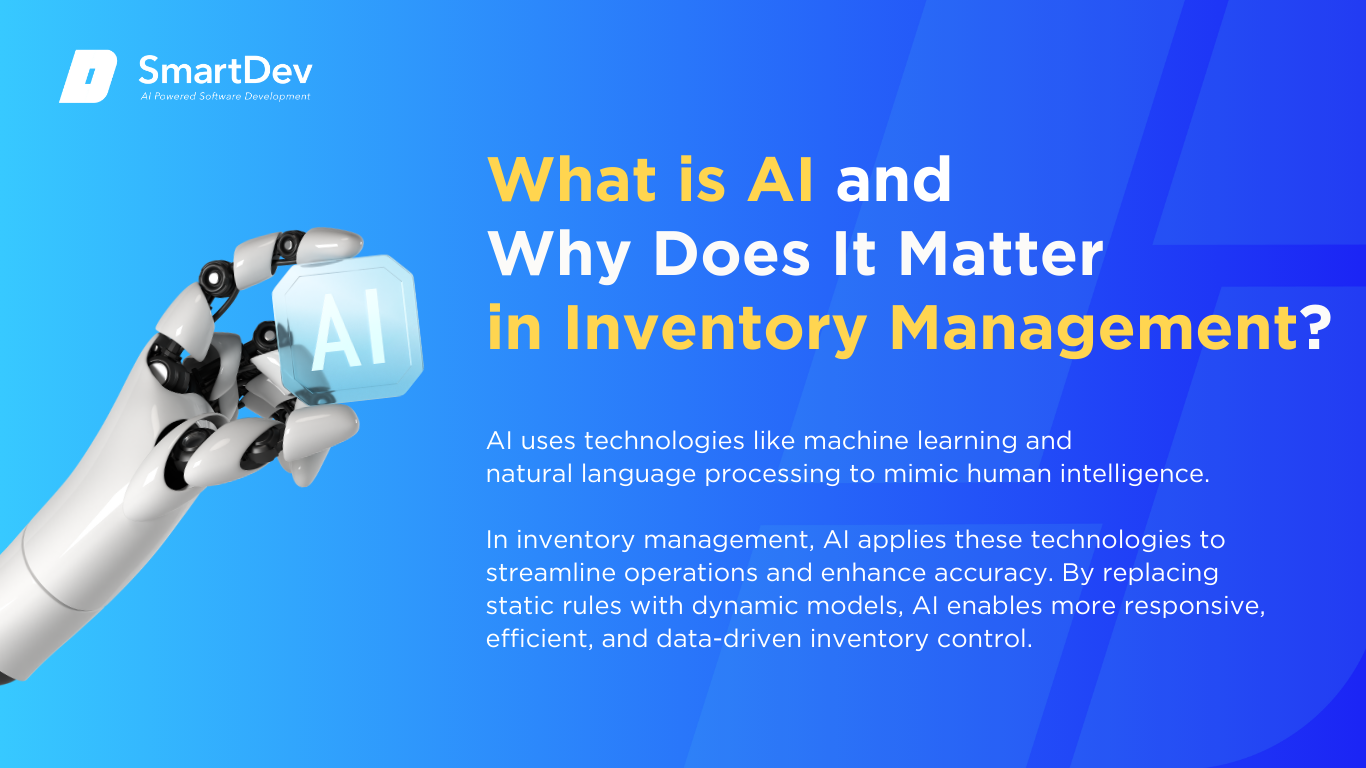
Definition of AI and Its Core Technologies
Artificial Intelligence refers to computer systems capable of performing tasks that typically require human intelligence, such as learning from data, recognizing patterns, and making decisions. Its core technologies include machine learning, natural language processing, and computer vision. These tools allow systems to analyze vast datasets, adapt over time, and automate complex tasks with minimal human intervention.
In inventory management, AI applies these technologies to streamline operations and enhance accuracy. It processes historical sales data, supplier metrics, and real-time inputs like sensor data to forecast demand and optimize stock levels. By replacing static rules with dynamic models, AI enables more responsive, efficient, and data-driven inventory control.
The Growing Role of AI in Transforming Inventory Management
Leading retailers are increasingly using AI to move beyond reactive inventory practices. Companies like Target generate billions of weekly demand forecasts to tailor stock distribution by region and product type. This shift allows them to avoid both overstock and out-of-stock scenarios while improving shelf availability.
Cold storage and perishable goods logistics are also seeing transformation through AI adoption. Firms such as Lineage Logistics and Americold use computer vision and predictive analytics to manage storage conditions and reduce spoilage. These systems improve operational safety and automate inventory tracking in environments where manual handling is challenging.
AI is also enabling real-time decisions across supply chains through sensor data and autonomous systems. Predictive models analyze consumption trends and reorder points, while generative tools simulate demand shifts to guide planning. Some companies now rely on agent-based AI to initiate stock transfers or supplier orders without human input, creating a more agile and resilient inventory ecosystem.
Key Statistics and Trends Highlighting AI Adoption in Inventory Management
AI adoption is growing rapidly across industries. McKinsey’s 2024 report shows 78% of organizations now use AI in at least one function, with nearly 50% using it in multiple areas including inventory and supply chain. Inventory management remains one of the most common entry points for operational AI.
The global market for AI in inventory management was valued at $5.7 billion in 2023 and is projected to reach $21 billion by 2028, growing at a 29.5% CAGR. These figures underscore rising demand for smarter forecasting, automation, and cost control in warehousing and logistics. Companies are accelerating investments to keep pace with AI-driven competitors.
Smaller firms are lagging but starting to catch up. A 2024 Netstock survey found only 23% of SMBs currently use AI for inventory, but over half plan to invest within two years. The focus is on demand forecasting, replenishment, and reducing manual errors – key drivers for AI’s growing adoption in inventory workflows.
Business Benefits of AI in Inventory Management
AI is solving long-standing inefficiencies in inventory management by making processes smarter, faster, and more responsive. From forecasting to fulfillment, it delivers measurable improvements in accuracy, cost control, and operational agility.
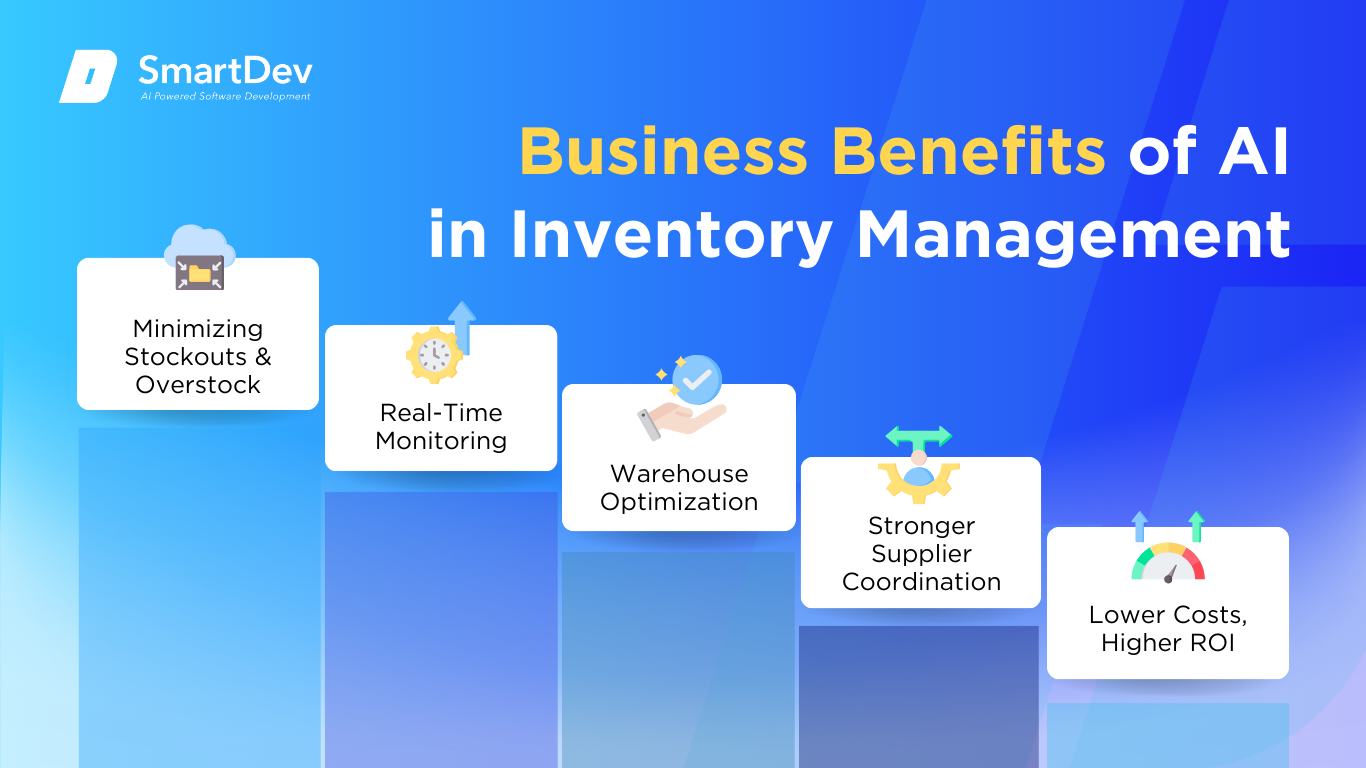
1. Minimizing Stockouts and Overstock
AI models analyze historical sales, promotions, seasonal trends, and external factors like weather or market shifts to forecast demand more accurately than traditional methods. This predictive accuracy helps businesses maintain optimal stock levels, reducing both lost sales from stockouts and waste from overstock. Major retailers like Walmart and Target now use AI-driven forecasting to reposition inventory by store and region, improving availability and reducing markdowns.
By continuously learning from new data, AI systems adapt to changes in demand patterns, such as shifting customer preferences or regional buying behavior. This dynamic forecasting allows businesses to proactively adjust inventory before issues arise. As a result, service levels improve while holding costs decrease, delivering a direct impact on revenue and operational efficiency.
To learn how AI evaluates risk and anticipates market shifts with precision, see our guide on AI credit evaluation in finance.
2. Real-Time Monitoring and Replenishment
AI systems integrate with point-of-sale (POS), warehouse, and supplier systems to provide real-time visibility into inventory across the supply chain. By analyzing live data, AI identifies inventory imbalances and triggers automated replenishment when stock falls below threshold levels. This removes the need for manual checks and reduces the risk of human error in reordering.
Companies using AI-based replenishment systems experience faster response times and fewer fulfillment delays. These systems also account for supplier lead times and transit data, helping to optimize reorder schedules. The result is smoother operations and better alignment between stock availability and actual customer demand.
To see how AI-powered systems transform inventory visibility and workflow efficiency in real business scenarios, explore our case study on smart consulting for inventory and workflow management.
3. Warehouse Optimization
AI analyzes order history and picking patterns to suggest the most efficient layout of products within a warehouse. Frequently picked items are placed in more accessible locations, while co-purchased products are grouped to minimize picker travel time. This intelligent slotting reduces labor costs and speeds up order fulfillment.
By continuously learning from warehouse operations, AI can adapt layouts as demand changes over time. It can also simulate different configurations to test performance improvements before implementation. This leads to higher throughput and greater warehouse productivity without increasing labor or footprint.
4. Stronger Supplier Coordination
AI evaluates supplier performance metrics such as on-time delivery, quality, and lead time variability to identify risks and suggest alternatives. This enables companies to proactively adjust sourcing strategies and avoid disruptions before they impact inventory. In complex supply chains, AI helps optimize inventory placement across multiple tiers – from distribution centers to retail outlets.
Multi-echelon inventory models powered by AI coordinate safety stock and reorder points across locations, not just at individual nodes. These systems improve stock availability while minimizing redundant inventory across the network. As a result, businesses can respond faster to disruptions and maintain service levels with lower overall stock.
5. Lower Costs, Higher ROI
AI reduces excess inventory and avoids unnecessary procurement by aligning stock levels with actual and forecasted demand. This directly lowers carrying costs, including storage, insurance, and obsolescence risk. Companies often see a 15–30% reduction in inventory levels after implementing AI-based systems.
Lower inventory means less working capital tied up in unsold goods, improving cash flow and financial flexibility. AI also optimizes logistics by reducing expedited shipping and consolidating shipments. These savings add up, making AI not only a tool for accuracy, but a driver of measurable financial returns.
Challenges Facing AI Adoption in Inventory Management
Despite its potential, implementing AI in inventory operations comes with real-world hurdles. Organizations must overcome technical, organizational, and resource-related barriers to fully realize AI’s value.

1. High Implementation Costs
Deploying AI in inventory management requires significant investment in software, infrastructure, and integration. Many businesses underestimate the full cost, which includes data migration, training, and system upgrades. For small and mid-sized companies, these expenses can be a major barrier to adoption.
Even for larger firms, ROI may take time to materialize. If models are not aligned with business priorities, results may fall short of expectations. This makes careful planning and phased rollout critical to success.
2. Fragmented and Unreliable Data
AI systems depend on clean, unified data from sales, suppliers, and inventory sources. Many businesses struggle with siloed systems and inconsistent records that reduce forecast accuracy. Without standardized, high-quality data, AI outputs are often unreliable.
Integrating data across platforms can be technically complex and labor-intensive. Ongoing data governance and cleansing are needed to maintain accuracy over time. This remains one of the most cited obstacles in AI adoption efforts.
3. Skills Gaps and Internal Resistance
AI requires specialized skills in data science, analytics, and inventory strategy – capabilities many companies lack in-house. Existing teams may struggle to interpret model outputs or trust automated decisions. This slows adoption and leads to underutilized systems.
Change management is equally important. Shifting from manual to automated processes often meets resistance from staff used to legacy workflows. Training and internal communication are essential to build trust and adoption.
To understand how AI systems can handle complex, high-risk data environments with accuracy, explore our fraud detection approach for e-commerce businesses.
4. Security and Vendor Risks
Integrating AI with inventory systems can expose sensitive supplier, pricing, and operational data. If systems are not secure, businesses face increased risk of breaches or data leaks. This is especially important when relying on third-party AI vendors.
Compliance with data privacy regulations adds further complexity. Companies must ensure secure data handling across internal and external systems. Without proper controls, these risks can outweigh the benefits of automation.
5. Model Degradation Over Time
AI models are not static, they must be retrained as demand patterns, product assortments, or supplier behavior evolves. Without regular updates, predictions lose accuracy and performance drops. This can lead to poor inventory decisions and eroded confidence in the system.
Monitoring and maintaining models requires dedicated resources and processes. Businesses without clear model governance may fall behind. Long-term success depends on treating AI as an evolving capability, not a one-time install.
Specific Applications of AI in Inventory Management
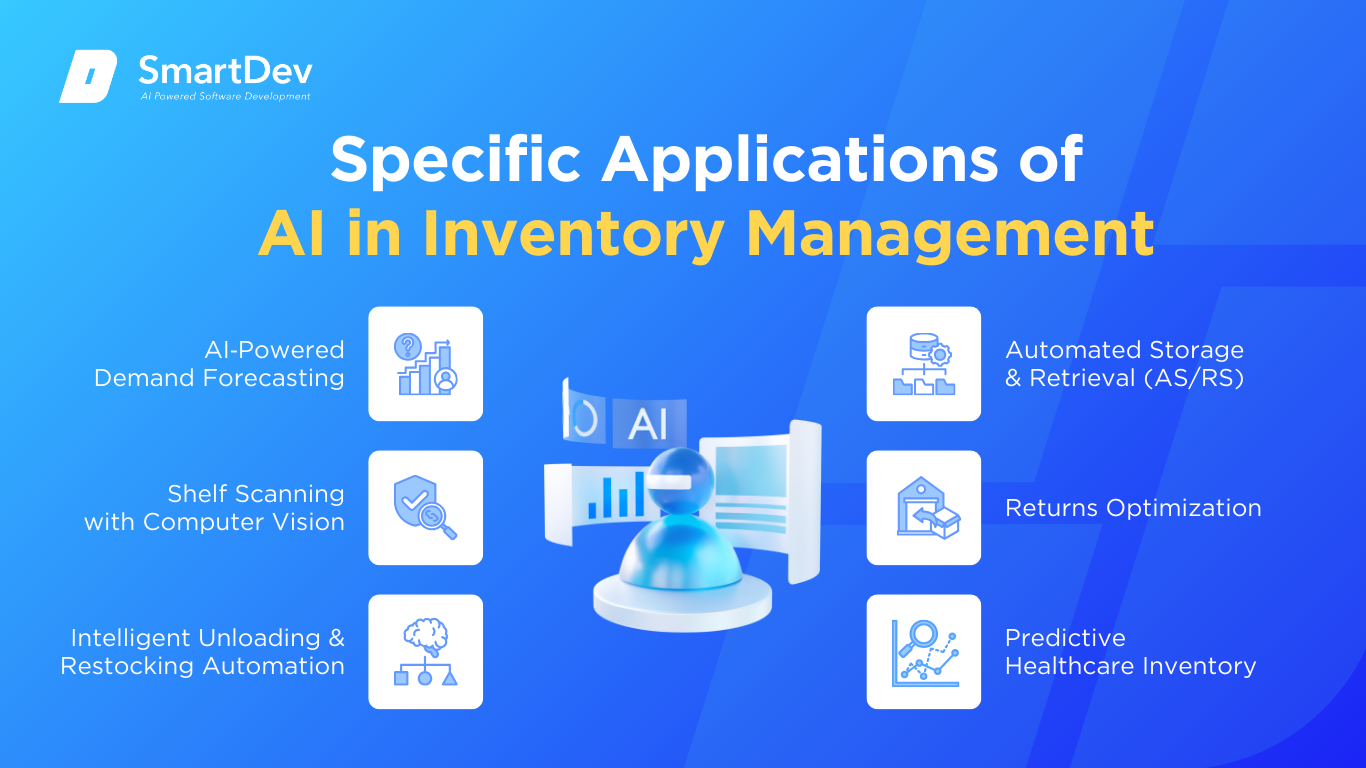
1. AI‑Powered Demand Forecasting
AI‑powered demand forecasting addresses inventory inefficiencies by analyzing historical sales, promotional calendars, seasonal trends, and external signals like weather. It leverages machine learning methods such as time-series neural networks and regression models that process large datasets and integrate with ERP or replenishment systems. This capability delivers strategic value through significant improvements in forecast accuracy, reduced safety stock, higher fill rates, and minimized stockouts – industry sources report forecasting accuracy gains of 10–20% and revenue uplift of 2–3%.
Model inputs include POS data, inventory levels, external datasets, and demand signals, enabling dynamic adjustment to ordering workflows. Implementing teams run continuous model experiments using platforms such as Amazon Forecast, feeding forecasts into automated ordering pipelines. The method reduces forecast errors by 20‑50%, cuts lost sales up to 65%, and lowers inventory costs through smarter procurement cycles.
AI demand forecasting systems improve service levels by reducing excess inventory and balancing stock distribution across channels. They enhance responsiveness to promotions or irregular demand spikes, enabling agile reordering and reducing overstock waste. Ethical and technical considerations include ensuring model transparency, avoiding bias in data sources, maintaining data privacy, and enabling scalable deployment in large SKU catalogs.
Real-world example:
More Retail Limited (MRL) in India adopted Amazon Forecast in collaboration with Ganit, boosting forecast accuracy from 24% to 76%, raising in-stock rates for fresh produce from 80% to 90%, reducing fresh waste by up to 30%, and increasing gross profit by 25%.
2. Shelf Scanning with Computer Vision
Computer vision shelf‑scanning solves hidden out-of-stock issues, price errors, and planogram non-compliance by capturing shelf images. Robots or fixed cameras equipped with 2‑D/3‑D vision and LiDAR feed image data into recognition models that detect discrepancies for human or system follow-up. Operationally, it enables faster detection of problems, improves shelf accuracy, and frees labor for higher-value tasks.
These systems continuously monitor shelf states, capturing terabytes of image data and overlaying AI models to classify item presence and arrangement. The data integrates into store dashboards or alerts for restocking triggers, helping staff act proactively. The benefit includes significantly reduced shrinkage, improved product availability, and better execution of merchandising plans.
Key deployment considerations include ensuring camera coverage, managing visual occlusions, integrating with workforce systems, and addressing privacy concerns. Hardware and vision models must generalize across varied store layouts, lighting conditions, and product packaging designs. Scalability challenges include cost of robot deployment and maintenance, as well as change management with staff.
Real-world example:
Walmart deployed Bossa Nova shelf‑scanning robots in hundreds of stores. Initial rollouts reported robots being 50% more productive and three times faster than manual scanning, leading to measurable reductions in out‑of‑stock items and improved shelf compliance across approximately 500 stores.
3. Intelligent Unloading & Restocking Automation
AI-driven unloading and restocking automation optimizes the scheduling and routing of inbound goods fulfillment. It processes real-time shipment data, store layout, and demand forecasts using ML models to sequence unloading and restocking tasks efficiently. The result is faster shelf replenishment, reduced labor hours, and improved product availability.
Integration with warehouse management systems enables dynamic assignment of dock doors and restocking zones. Models adapt to peak volumes or promotions, ensuring critical SKUs are prioritized. Strategic benefits include labor cost reductions, accelerated restock cycles, and minimized stockouts.
Technical considerations include interoperability with logistics systems, accurate mapping of store zones, and real-time tracking of tasks. Ensuring algorithm transparency and fairness in stock routing is crucial. Systems must scale across multiple distribution centers with minimal latency.
Real-world example:
Walmart’s internal “FAST Unloader” AI system predicts optimal unload sequences and restocking paths. The system reportedly reduced labor costs by up to 20% and cut stockout rates by around 25%, thanks to more efficient shelf replenishment operations.
4. Automated Storage & Retrieval (AS/RS)
AI-enhanced AS/RS systems leverage robotic fleets operating within 3D storage grids to retrieve items on demand. They combine computer vision, path planning, and item identification to navigate modular racking and fulfill orders with minimal human labor. These systems offer high-density storage, reduced picker travel, and faster throughput in fulfillment centers.
Robots coordinate via AI orchestration layers that optimize inventory retrieval sequences and balance load across multiple units. Integration into warehouse management systems allows synchronized order assignment and stock movement. Strategic value includes an up to 85% reduction in warehouse footprint, faster order cycles, and scalable fulfillment throughput.
Technical and ethical considerations involve safe human-robot interaction, system redundancy, and equitable task distribution. Scalability must address diverse SKU dimensions and weight categories. Maintaining system reliability and recovery protocols is essential for operational continuity.
Real-world example:
Attabotics’ AI-driven 3D AS/RS platform, adopted by companies including Nordstrom, reduces warehouse footprint by up to 85% and significantly speeds order fulfillment cycles, driving high labor efficiency and storage density gains.
5. AI for Returns Optimization
AI in reverse logistics classifies returned items – based on condition, demand, and resale value – and assigns optimal disposition channels such as resale, liquidation, or recycling. It employs classification models and decision automation integrated into returns workflows and returns management systems. This automates disposition judgments, accelerates processing, and maximizes value recovery.
The models require input data including SKU condition, return reason, secondary market pricing, and logistical cost parameters. Integrations with ERP and resale marketplaces enable execution of recommended routes. Operational benefits include reduced inventory tied in return cycles, revenue recouped via resale, and minimized disposal costs.
Key considerations are model accuracy, transparency, alignment with sustainability policies, and maintaining customer trust. Ethical concerns include fair pricing and environmental responsibility. Scalable deployments require integration across multiple return processing centers and real-time disposition decisions.
Real-world example:
Optoro’s OptiTurn platform applies AI to returns optimization for major retailers. It maximizes resale recovery, reduces disposition costs, and streamlines reverse logistics – helping clients recover more value, lower waste, and process returns faster in large-scale retail operations reported in industry analyses.
6. Predictive Healthcare Inventory
In healthcare, AI predicts shortages of critical supplies using data including usage patterns, supplier lead times, patient admission trends, and contract terms. These predictive models automate reordering triggers and optimize inventory allocation across facilities. The strategic result is consistent availability of essential items, minimized waste from expirations, and continuity of patient care.
Sensor data (e.g., RFID, temperature monitors) and inventory levels feed into forecasting models that generate alerts for restocking before stockouts occur. Integration with procurement and supplier systems enables proactive replenishment planning. Operational value includes improved contract compliance, reduced stock expiry losses, and optimized supply utilization.
Key technical concerns involve patient data privacy, regulatory compliance, model transparency, and ensuring robust failover. Ethical implementation must respect healthcare standards and avoid supply bias. Scalable adoption depends on integrating across hospital networks and aligning with clinical workflows.
Real-world example:
Major US healthcare systems such as Mayo Clinic and Cleveland Clinic have implemented AI-based inventory forecasting and robotic fulfillment processes for medical supplies. These systems reduced medical supply waste, improved stock accuracy, and enhanced contract management, resulting in fewer expirations and increased supply reliability during critical demand periods.
Need Expert Help Turning Ideas Into Scalable Products?
Partner with SmartDev to accelerate your software development journey — from MVPs to enterprise systems.
Book a free consultation with our tech experts today.
Let’s Build TogetherExamples of AI in Inventory Management
AI in inventory management is no longer theoretical – leading companies are deploying it at scale to drive measurable results. The following real-world case studies highlight how AI is transforming operations, improving accuracy, and reducing costs across different industries.
Real-World Case Studies
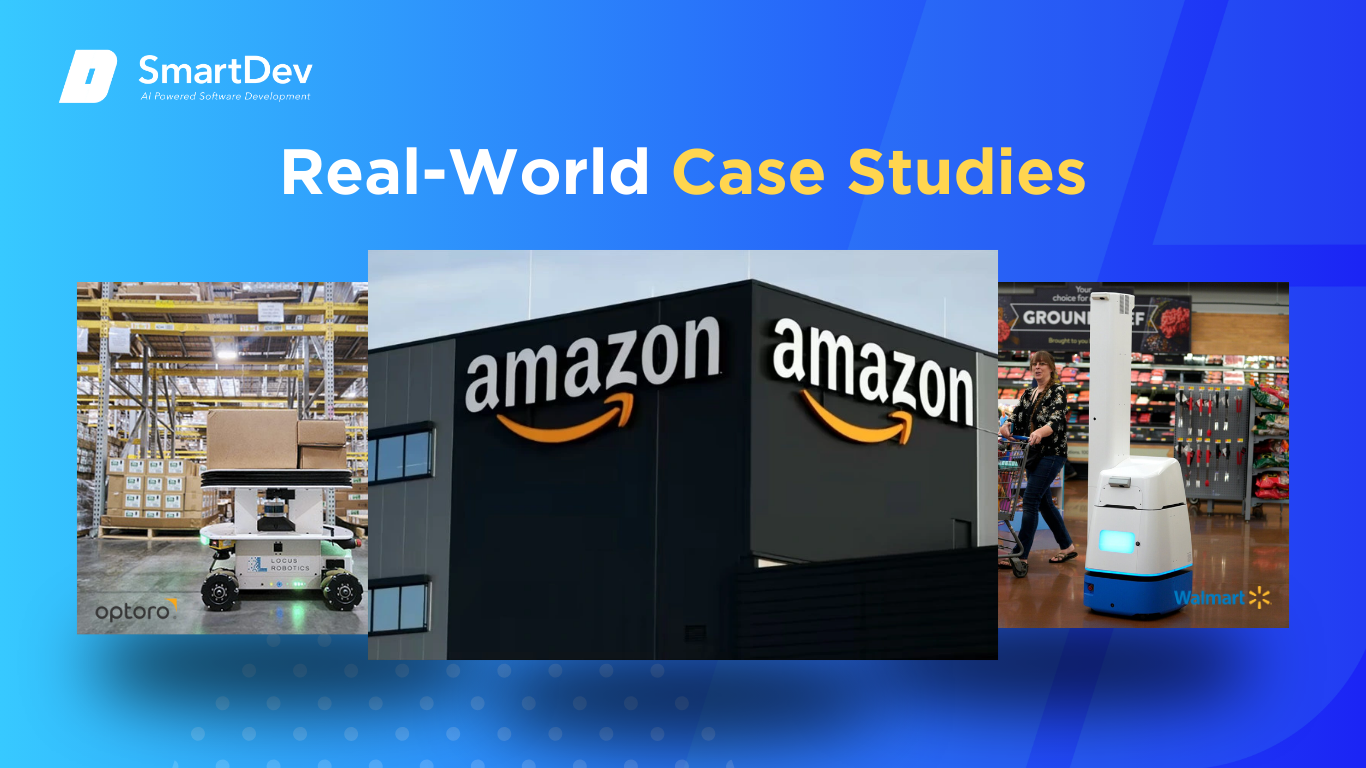
1. Amazon: AI‑Driven Demand Forecasting
Amazon employs sophisticated machine learning models that process historical sales, promotions, weather, and local event data to forecast demand across millions of SKUs. These forecasts feed into dynamic procurement and fulfillment systems that pre-position inventory in distribution centers or fulfillment nodes. As a result, Amazon achieved about a 15% reduction in stockouts, significantly improving inventory efficiency and service levels.
The AI models integrate into Amazon’s ordering infrastructure, automating reorder triggers and adjusting inventory placement based on near real-time demand signals. Forecast error reductions of up to 45% have also been reported in broader studies, contributing to faster inventory turnover and lower carrying costs. Operationally, this results in leaner inventory, fewer stockouts, and better alignment of availability with consumer demand at scale.
2. Walmart: In‑Store Shelf Scanning Robots
Walmart partnered with Bossa Nova Robotics to deploy mobile robots equipped with 2D/3D imaging and LiDAR sensors to scan aisles for out-of-stock items, misplacements, and price discrepancies. Early deployments in around 50 stores showed these robots operated 3× faster and up to 50% more accurate than manual audits in detecting shelf issues.
However, Walmart ended the contract after roughly five years and ~500-store trial due to changes in operations (e.g., increased in-aisle associates from online order fulfillment could perform inventory checks effectively). Still, these trials proved the value of computer vision for shelf visibility and highlighted trade-offs between automation and human flexibility.
3. Optoro: AI-Powered Returns & Reverse Logistics
Optoro’s SmartDisposition AI engine analyzes return data, including item condition, resale value, and logistics cost, to determine the most profitable disposition channels such as resale, liquidation, or recommerce. Their RMS platform is integrated into returns workflows and has helped retailers reduce processing costs by approximately 50% and increase repurchase rates two‑ to three‑fold.
By automating decisions at scale, Optoro enables faster routing of returns, higher recovery, and lower waste. Retailers using OptiTurn report significantly improved recovery rates – more returns are resold versus relegated to disposal – delivering better margins and sustainability impact.
Innovative AI Solutions
AI innovation in inventory management is accelerating through robotics and adaptive systems. Amazon-backed Skild AI recently launched Skild Brain, a general-purpose model enabling robots to handle complex warehouse tasks like stair climbing and clutter navigation. This leap advances automation beyond single-task robots, offering flexibility in dynamic inventory environments.
Agentic AI is also emerging – autonomous systems that manage inventory flows and restocking decisions with minimal oversight. Used in warehouse design and supply optimization, these AI agents outperform manual methods in complex conditions. Reinforcement learning models show promise for perishable goods and variable lead times, outperforming rule-based systems in simulations.
Explore how AI streamlines workflows and drives performance improvements in our guide to unlocking operational efficiency with AI.
AI-Driven Innovations Transforming Inventory Management
Emerging Technologies in AI for Inventory Management
Generative AI is transforming inventory planning by enabling dynamic simulations of demand scenarios. These tools generate insights by analyzing vast datasets, predicting shifts based on factors like seasonality or marketing trends. As a result, planners can make faster, more informed decisions about stock allocation and replenishment.
Computer vision is equally reshaping warehouse operations through real-time visual tracking of products. With image recognition and smart cameras, businesses can monitor shelf levels and detect misplaced or missing items automatically. This not only reduces manual labor but also ensures a higher level of inventory accuracy.
To find out how AI combined with blockchain delivers next-level transparency and forecasting accuracy, explore our fintech thought leadership insights.
AI’s Role in Sustainability Efforts
AI is playing a crucial role in reducing waste across supply chains by improving demand forecasting and inventory accuracy. With better predictions, businesses can avoid overstocking and minimize spoilage, especially in sectors handling perishable goods. This leads to fewer markdowns and a lower environmental impact from unsold inventory.
Smart systems powered by AI also help optimize energy usage in warehouses and distribution centers. By analyzing usage patterns, these systems adjust lighting, cooling, and storage operations for greater efficiency. Over time, this not only cuts costs but also significantly reduces carbon emissions.
How to Implement AI in Inventory Management
Implementing AI in inventory management isn’t just about adopting new tools, it’s about rethinking how your operations function. From data readiness to team training, each step plays a crucial role in unlocking real, measurable value from AI.
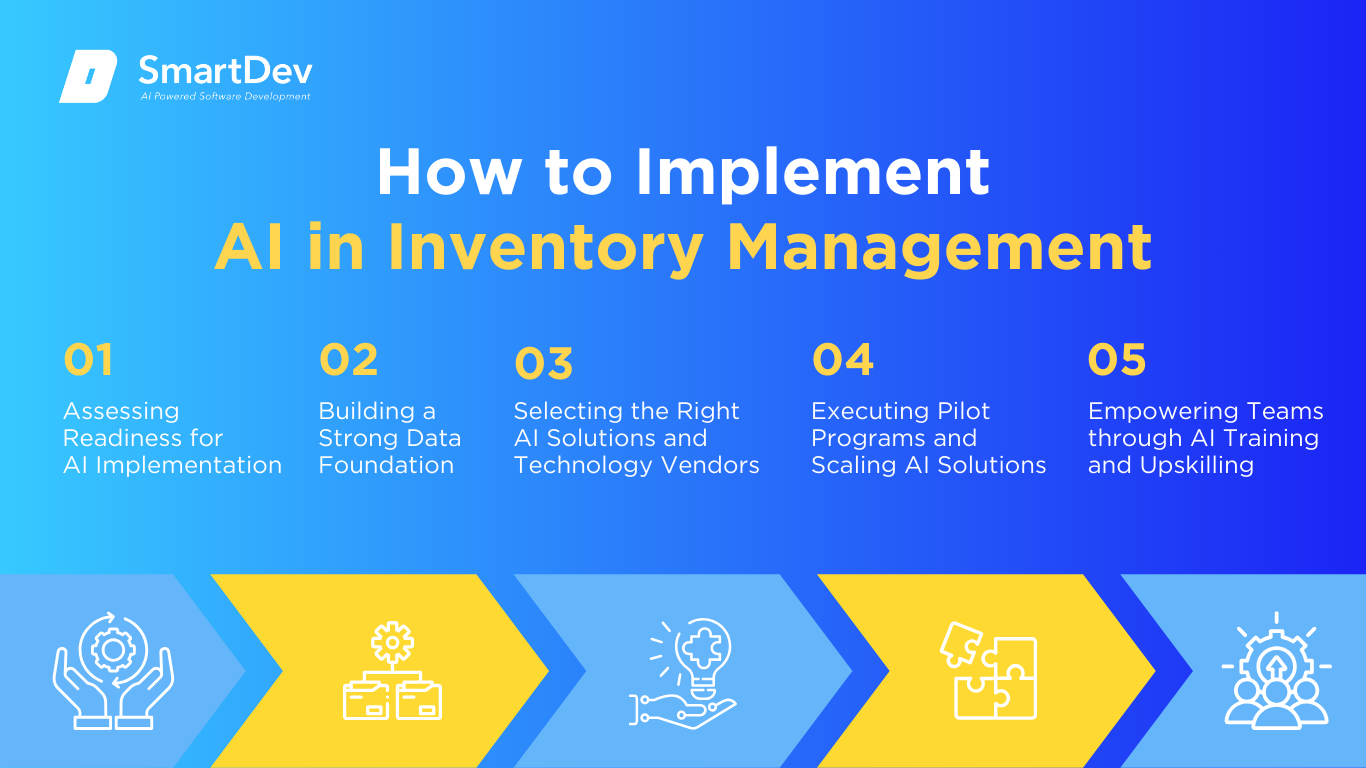
Step 1: Assessing Readiness for AI Adoption
Before integrating AI into your inventory operations, assess your organization’s current level of digital maturity. Focus on areas where decision-making still relies on gut instinct or manual tracking, like demand forecasting or reorder scheduling. These pain points typically yield the fastest results when optimized through AI.
You’ll also need to evaluate your team’s openness to innovation and change. AI adoption isn’t just a technology shift, it requires a cultural shift toward data-driven thinking. Without strong leadership support and clear communication, even the best AI strategy can stall at rollout.
Explore our data analytics services to see how we help businesses implement AI solutions that scale.
Step 2: Building a Strong Data Foundation
Successful AI systems depend on clean, reliable data pulled from across your operations. This means aligning sales history, supplier lead times, stock movement, and even returns data into a single accessible source. When your data is complete and structured, AI can deliver accurate, actionable insights.
It’s also critical to establish governance around how data is collected and maintained. Inconsistent SKU naming or gaps in inventory logs can distort results and undermine trust in your AI tools. Building this foundation early helps reduce friction and ensures models perform as expected.
Explore why clean, well-governed data is the foundation of successful AI adoption in our data management guide.
Step 3: Choosing the Right Tools and Vendors
Not every AI tool will fit your business model or operational structure, so be selective. Focus on solutions that solve your specific inventory challenges – whether it’s forecasting, replenishment, or real-time stock visibility – and that integrate smoothly with existing systems. Scalability and support should be non-negotiable.
Ask the hard questions about how these tools handle your data, from security to compliance and ownership. A transparent vendor will offer clear documentation, customization options, and ongoing updates. This kind of partnership makes AI adoption more sustainable and strategic in the long run.
Step 4: Pilot Testing and Scaling Up
Start small by testing AI in one region, product category, or warehouse to minimize disruption. Use this opportunity to track how AI recommendations compare with traditional methods in terms of accuracy and efficiency. These insights will guide how you scale across the rest of your network.
A successful pilot helps build confidence across the organization. Review key performance metrics and user feedback, then adjust your rollout strategy before going wider. With early proof of value, your team is more likely to embrace a full-scale implementation.
Step 5: Training Teams for Successful Implementation
Your AI tools are only as effective as the people using them. Train employees to understand how AI works, how to interpret its outputs, and when to intervene. The goal is to foster collaboration, not replacement.
Encourage regular communication between inventory teams and technical staff to ensure alignment. Practical use cases and ongoing support make adoption feel less intimidating. A well-prepared workforce ensures AI becomes an embedded, trusted part of your operations.
To ensure successful AI integration, institutions should start with a clear roadmap. Our guide for tech leads outlines how to assess readiness and align stakeholders from the start.
Measuring the ROI of AI in Inventory Management
Key Metrics to Track Success
Metrics such as inventory turnover, stockout frequency, and holding costs reflect AI’s influence on supply chain efficiency. Enhanced accuracy allows for leaner inventories without sacrificing availability or responsiveness.
Customer-facing metrics, including product availability and delivery reliability, reveal broader business benefits. When these areas improve alongside internal operations, AI delivers both short-term savings and long-term competitive advantages.
Case Studies Demonstrating ROI
Rastelli Food Group implemented RELEX’s AI-driven planning system and achieved a 927% ROI, recovering over $3 million in excess inventory and cutting planning time by 95%. The initiative also saved $250,000 annually in ongoing costs, yielding $11.90 for every $1 invested over three years.
At API Group, AI forecasting from Kortical led to an 8.5% reduction in excess stock and an 11% improvement in delivery lead-time accuracy. These gains freed up working capital and improved supply reliability for large-scale printing operations.
Common Pitfalls and How to Avoid Them
Poor data quality is a leading cause of failed AI outcomes. Without consistent, structured inputs, models struggle to produce reliable recommendations, weakening performance and trust.
Another common issue is low adoption due to unclear workflows or inadequate training. Aligning teams early, introducing AI gradually, and providing support ensures effective integration and long-term value.
Learn how to evaluate AI model effectiveness and ROI with our practical guide on AI performance metrics.
Future Trends of AI in Inventory Management

Predictions for the Next Decade
In the coming years, AI will shift from supportive tools to autonomous systems capable of managing inventory across entire networks. Reinforcement learning, agent-based models, and digital twins will enable real-time decision-making that adapts instantly to demand shifts, disruptions, and supply chain volatility.
AI will also integrate more deeply with IoT, blockchain, and computer vision to create seamless, real-time visibility from warehouse to delivery. This will drive greater transparency, predictive control, and operational resilience, making advanced inventory management accessible not just to large enterprises but to mid-sized businesses as well.
To see which emerging technologies are shaping AI adoption in the next decade, our IT landscape trends recap and guide for business to intergrating AI in 2025 breaks down the must-watch shifts for business leaders.
How Businesses Can Stay Ahead of the Curve
Staying ahead requires building a flexible data infrastructure and embracing continuous experimentation with emerging AI technologies. Businesses that invest in scalable platforms, cross-functional collaboration, and clean, real-time data pipelines will be best positioned to adapt as AI capabilities evolve.
Proactive organizations are also exploring digital twins, autonomous agents, and sensor-driven analytics in sandbox environments before full deployment. By fostering a culture of innovation and aligning AI initiatives with long-term goals, businesses can turn inventory management into a strategic advantage rather than a reactive task.
Conclusion
Key Takeaways
AI is reshaping inventory management by enhancing forecasting accuracy, reducing waste, and enabling real-time decision-making across the supply chain. From generative models and computer vision to reinforcement learning and smart automation, AI tools are driving measurable gains in efficiency, cost savings, and service reliability.
Real-world case studies show that when implemented with a strong data foundation and aligned strategy, AI can deliver rapid ROI and long-term value. As technologies advance and become more accessible, AI is no longer a competitive edge reserved for large enterprises, it is becoming a necessary asset for any organization aiming to manage inventory with precision and resilience.
Moving Forward: A Strategic Approach to AI-Driven Transformation
AI is rapidly redefining inventory management – streamlining stock control, minimizing waste, and unlocking efficiency at every level of the supply chain. From automating demand forecasts to improving fulfillment speed and service accuracy, AI is no longer a future advantage, it’s a present necessity for businesses aiming to stay competitive.
At SmartDev, we specialize in delivering AI-powered inventory solutions built to match the complexity of your operations. Whether it’s predictive planning, real-time tracking, or system integration, our team ensures each solution drives measurable impact and scales with your growth.
Explore our AI-powered software development services to learn how we help businesses reduce excess stock, improve availability, and cut operational costs through intelligent automation.
Contact us today to start building an AI-driven inventory strategy that boosts performance, resilience, and long-term value.
—
References:
- What is AI inventory management? | IBM
- AI is slowly transforming the cold chain, the supply chain that handles your ice cream and deli meat | Business Insider
- Inventory Management 2024 Benchmark Report | Netstock
- AI in Inventory Management Market 2025 – Demand & Trends | The Business Research Company
- The state of AI in early 2024: Gen AI adoption spikes and starts to generate value | McKinsey & Company
- Improving Retail Forecast Accuracy with Machine Learning | Amazon Web Services
- How AI Demand Forecasting is transforming stock management and order fulfilment How AI Demand Forecasting is transforming stock management and order fulfilment | HSO
- Bossa Nova’s inventory robots are rolling out in 1,000 Walmart stores | TechCrunch
- AI-driven demand forecasting: Enhancing inventory management and customer satisfaction | ResearchGate
- Walmart Scraps Plan to Have Robots Scan Shelves | The Wall Street Journal
- Structure-Informed Deep Reinforcement Learning for Inventory Management | arXiv







